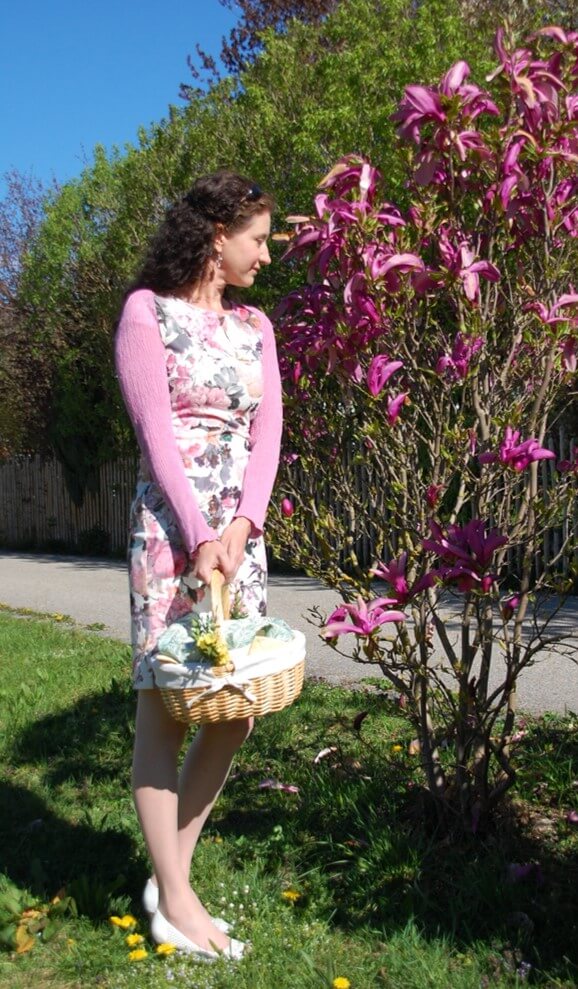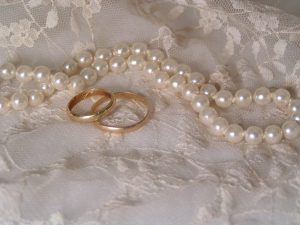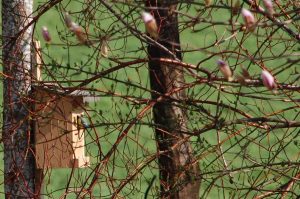Anatomy of a Bavarian Easter Basket
It’s that time of year. Pictures of Easter baskets are filling my newsfeed on Facebook.
Actually, I had a friend lamenting the fact that the first Easter baskets were showing up in stores right after Valentine’s Day. Crazy!
All the Easter baskets seem to be quite similar. There is a bunny (or other stuffed animal), lots of chocolate, peeps, hard boiled eggs (I really hope they’re not raw), and candy all nestled on grass in a decorative basket.
I always wanted one of those. They were around when I was a child, but my parents were more pragmatic and we did not need more presents. I also remember those baskets being really quite expensive. I did not know one child who got one.
For those under the age of 25—this was pre-internet and pre-pre-Pinterest era. I know, a time existed when we did NOT know what we were all missing out on. I must have been deprived, but I really don’t think so. I’ve never missed the Easter basket I didn’t receive and the deprivation did not send me to therapy.

So, why do I make Easter baskets now? Why was my first gift from my Mother-in-law a Bavarian Easter basket? Why, in fact, does Thomas takes pictures of me with my basket every Easter Sunday?
Have we gone hoppy? Are we Easter fanatics? Am I just discovering the child in me and did I really need that therapy I just said I didn’t? Do we just go overboard on every holiday season making the most of chocolate and candy?
No. No. No. Well, I’ve got to admit it’s a ‘yes’ to that last one. In our family, any celebration is reason enough for chocolate. But on to my basket.
A Holy Day is a Holiday
My Easter basket is a Bavarian Easter basket. And it has to do with the Holy Day of Easter, not the holiday.
Living in Bavaria, especially my corner of Bavaria, is living in a Catholic culture. Catholicism colors the traditions and holidays we celebrate.
The Christian celebration of Easter is arguably the largest holiday of the year. Yes, Virginia, it is greater than Christmas. I know! I was shocked too, when I heard that.
Thomas and I have a tradition of joining his parents for Church in their local parish. Our first year, we were dating and his Mom decided this American girl needed an Easter basket to bring to Church just like the Bavarian families did.
The First Year
The first year, we went to Thomas’ parents before church service. She handed me a basket with an embroidered linen napkin covering the contents. It is the same one I use today and always will. We put the basket on the table and she showed me what was inside. She had ensured that all the traditional elements were there, including a home-baked Easter lamb.
Every year after that morning, I make sure to pack my basket before meeting Thomas’ family at the church.
Some elements I am still working on and others I am still learning about.
Actually, packing an Easter basket is easy. The symbolism behind it is as simple as it is profound. All of these symbols can be transferred across all Christian beliefs.
Bread
Christ is the Bread of Life. He is the center of the holiday we are celebrating today. Without his Life, we would have no need for any other holiday season we may have. Christmas would mean nothing without His sacrifice.
Bread is also a Staff of Life. Without food, we cannot survive. It is central to meals of this region.
Salt
Christ calls his followers to be the Salt of the Earth.
In many cultures, salt is a traditional gift when blessing a new house, a new marriage, a new covenant.
In times not so long past, it was the most valuable food in your house. The word “salary” is derived from the Latin word for salt (sale). Wealthy Romans were often paid their wages in salt. It truly was worth more than its weight in gold.
Salt is not only for adding flavor to food, as it is today. Salt is, and always has been, first and foremost a preservative and healing agent. Without it, meat and produce would not survive throughout long winters. It can literally save your life–not just improve it.
Meat
Meat of various kinds can be added. This symbolizes wealth and abundance in its most simple form. Some sources offer detailed reasoning behind every kind of meat. However, when all is taken into account, every single type of meat people choose to include is a symbol for blessing and God’s Grace.
Eggs
Colored hard-boiled eggs are added to the basket as symbols of Easter, the Resurrection and new life to come.
The Lamb
Enter any bakery around Easter and you will see cakes in the form of a lamb lined up on the counter. Many will have a wooden cross on them. These are the Easter lambs.
Traditionally they would be hand-made. I am fortunate to have two women in our family who are fabulous bakers. Thomas’ Mom makes sure that we will always have our Easter lamb, made with love and hand delivered the day before Easter.
This is by far the largest element in our basket and the central one placed on top. The symbol of the Lamb of God. The center of the entire Christian ritual of Easter. The sacrifices of ancient Israel made true.
Candle
Often not in the basket but brought in a lantern. The candle is lit on the Easter candle in the church to be carried home for the Easter meal and to burn throughout the Easter celebrations.
Other Contents
There are other foods which may be added. People who do not eat meat, often add cheese in its stead. I add cheese and butter, which are traditional in parts of Austria. Others may include horseradish as a symbol of Passover’s “bitter herbs”. No one sees the contents and no one really cares. It is a tradition as real and solid as any other tradition but also carried out with Grace.
The contents of the basket are then carefully covered with a decoratively stitched cloth. The contents are not on display and it is not meant for people to use the baskets to show their wealth.
Decorations
The baskets are decorated with laurel (boxwood), pussy willows and spring flowers, as well as colorful ribbons and an Easter pennant of red and white embroidered with the Easter cross.
Tradition
Before services begin, the baskets are brought to the front of the church and left by the altar to be blessed. At the end of the service, the priest offers a blessing on the congregation and then blesses the food before him.
Simple Blessings
The blessing in our home parish is always a simple one:
Bless the food before us and the hands that have prepared it. Thank you for the prosperity You have shown us throughout the year and continue to bless us throughout the coming year. Bless each of the families as they join around the Easter feast to celebrate the holidays together and keep them safe. Hear their prayers and let them sense Your presence now and in the coming year.
Adding Our Own Tradition
Thomas and I have added our own tradition. After the church service, when we have said good bye to his parents (usually after making a coffee date later in the afternoon), we head home. If the weather is nice, we then take our basket, add something to drink, maybe a few carrots, and head out for a simple picnic. Everything we need has already been provided: in my Easter basket.








